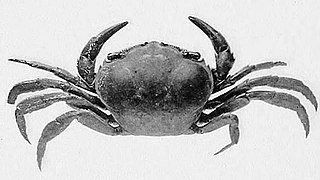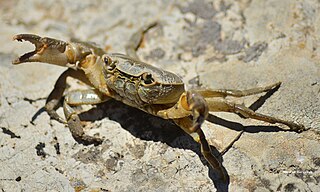Globonautes macropus is a species of crab in the family Potamonautidae, the only species in the genus Globonautes. It is found in Guinea and Liberia and presumably in Sierra Leone, and is listed as an endangered species on the IUCN Red List. It lives in tree hollows filled with water, in closed-canopy rainforest.
Louisea is a genus of freshwater crab in the family Potamonautidae, containing two species, Louisea balssi and Louisea edeaensis. Both species are endemic to Cameroon and listed as endangered species on the IUCN Red List.

Potamonautes is a genus of African freshwater crabs in the family Potamonautidae. It is both the most widespread and most diverse genus of African freshwater crabs, including more than half the species of this continent. They are found in most freshwater habitats of the African mainland and some species are semi-terrestrial.
Potamonautes choloensis is a species of freshwater crustacean in the family Potamonautidae.
Potamonautes gerdalensis is a species of crab in the family Potamonautidae. It is found in the Democratic Republic of the Congo, Kenya, Tanzania, and Uganda. Its natural habitats are rivers and freshwater lakes. It is threatened by habitat loss.
Potamonautes gonocristatus is a species of crab in the family Potamonautidae. It is endemic to Lake Kivu, on the border between the Democratic Republic of the Congo and Rwanda.
Rotundopotamonautes ignestii is a species of crab in the family Potamonautidae. It is found in Ethiopia.

Potamonautes johnstoni is a species of freshwater crab in the family Potamonautidae. It is found in rivers in Kenya and Tanzania, with unconfirmed records from Malawi and the Democratic Republic of the Congo. The species' distribution includes Kilimanjaro, Nekona, Mrogoro and the Usambara Mountains.

Potamonautes lirrangensis, the Malawi blue crab, is a species of freshwater crab in the family Potamonautidae. This common and widespread species is found in Lake Malawi, Lake Kivu, the upper Congo River Basin and Malagarasi River in the Democratic Republic of the Congo, Malawi, Rwanda, and Tanzania. In the freshwater aquarium trade it is sometimes sold under the synonym Potamonautes orbitospinus.
Potamonautes mutandensis is an endangered species of freshwater crab in the family Potamonautidae. It is found in Lake Mutanda and Lake Kivu in Uganda, Rwanda and DR Congo.
Potamonautes niloticus is a species of freshwater crab in the family Potamonautidae. It is found in the Nile Basin in Egypt, Ethiopia, Rwanda, Sudan, and Uganda. Numerous specimens of P. niloticus are known from Miocene deposits around Lake Albert.
Potamonautes obesus is a species of crab in the family Potamonautidae. It is found in Kenya, Malawi, Mozambique, Somalia, Tanzania, Zambia, and Zimbabwe. Its natural habitat is swamps.
Arcopotamonautes unisulcatus is a species of crab in the family Potamonautidae. It is only found in the Uluguru Mountains, Tanzania.

Potamonautidae is a family of freshwater crabs endemic to Africa, including the islands of Madagascar, the Seychelles, Zanzibar, Mafia, Pemba, Bioko, São Tomé, Príncipe and Sherbro Island. Fossil remains dating from the Late Miocene period have been attributed to the family Potamonautidae.

Deckenia is a genus of freshwater crabs from East Africa, in the family Potamonautidae, or sometimes in a family of its own, Deckeniidae. The genus was named by Hilgendorf after Karl Klaus von der Decken who collected the first examples during his expeditions to Africa. Both species live in swamps from Eyl in Somalia to Dar es Salaam, Tanzania, both in coastal areas and further inland. A third species, Deckenia alluaudi, lives in the Seychelles, and has been transferred to a separate genus, Seychellum.

Trichodactylidae is a family of crabs, in its own superfamily, Trichodactyloidea. They are all freshwater animals from Central and South America, including some offshore islands, such as Ilhabela, São Paulo. Only one of the 50 species is known from the fossil record, Sylviocarcinus piriformis from the Miocene of Colombia. The family contains 15 genera in two subfamilies:

Potamon algeriense is a freshwater crab found in North Africa.

Potamonautes sidneyi is a species of freshwater crab in the family Potamonautidae. The common name is the Natal river crab or Sidney's river crab, although they may also be referred to as "river crabs", "fresh water crabs" or "land crabs".

Around 1,300 species of freshwater crabs are distributed throughout the tropics and subtropics, divided among eight families. They show direct development and maternal care of a small number of offspring, in contrast to marine crabs, which release thousands of planktonic larvae. This limits the dispersal abilities of freshwater crabs, so they tend to be endemic to small areas. As a result, a large proportion are threatened with extinction.
Tanzanonautes tuerkayi is a species of fossil freshwater crab from Tanzania, the only species in the genus Tanzanonautes. It is the oldest known freshwater crab, and probably dates from the Oligocene; the next oldest specimens are from the Miocene. A number of fragmentary remains were discovered in the Songwe Valley part of the East African Rift in Mbeya Region, Tanzania, in fragile sandstone sediments. The animal had a carapace around 50 millimetres (2.0 in) across the widest part, which is around 15 mm (0.6 in) from the front of the carapace; the carapace is 44 mm (1.7 in) from front to back, and the slightly inward-curving rear edge of the carapace is 28 mm (1.1 in) across. The genus name refers to Tanzania, the country where the fossil was found, while the specific epithet commemorates Michael Türkay, an authority on freshwater crabs. The genus Tanzanonautes is assigned to the family Potamonautidae, although the characters mentioned in the family's diagnosis are missing from the fragmentary fossils available.









